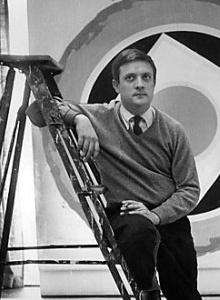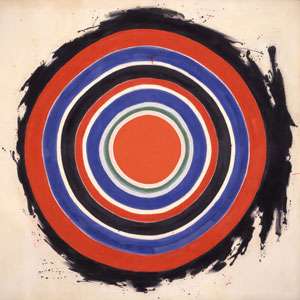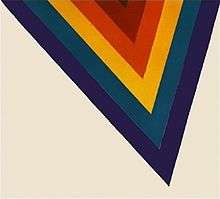Kenneth Noland
| Kenneth Noland | |
|---|---|
 | |
| Born |
April 10, 1924 Asheville, North Carolina, U.S. |
| Died |
January 5, 2010 (aged 85) Port Clyde, Maine, U.S. |
| Nationality | American |
| Education | Black Mountain College |
| Known for | Abstract art |
| Movement | Color Field painting |
| Website | Official site |
Kenneth Noland (April 10, 1924 – January 5, 2010) was an American painter. He was one of the best-known American Color Field painters, although in the 1950s he was thought of as an abstract expressionist and in the early 1960s he was thought of as a minimalist painter. Noland helped establish the Washington Color School movement. In 1977, he was honored by a major retrospective at the Solomon R. Guggenheim Museum in New York that then traveled to the Hirshhorn Museum and Sculpture Garden in Washington, D.C. and Ohio's Toledo Museum of Art in 1978. In 2006, Noland's Stripe Paintings were exhibited at the Tate in London.
Early life and education
A son of Harry Caswell Noland (1896–1975), a pathologist, and his wife, Bessie (1897–1980), Kenneth Clifton Noland was born in Asheville, North Carolina. He had four siblings: David, Bill, Neil and Harry Jr.[1][2]
Noland enlisted in the U.S. Air Force in 1942 after completing high school. A veteran of World War II, Noland took advantage of the G.I. Bill to study art at the experimental Black Mountain College in his home state of North Carolina.[3] At Black Mountain, where two of his brothers also studied art, Noland studied with Ilya Bolotowsky, a professor who introduced him to neoplasticism and the work of Piet Mondrian. There, Noland also studied Bauhaus theory and color under Josef Albers[4] and became interested in Paul Klee, specifically Klee's sensitivity to color.[5]
Career

In 1948 and 1949 Noland worked with Ossip Zadkine in Paris, and had his first exhibition of his paintings there. In the early 1950s he met Morris Louis in Washington, D.C. while teaching night classes at the Washington Workshop Center for the Arts. He became friends with Louis, and after being introduced by Clement Greenberg to Helen Frankenthaler and seeing her new paintings at her studio in New York City in 1953, he and Louis adopted her “soak-stain” technique of allowing thinned paint to soak into unprimed canvases.[6]
Most of Noland's paintings fall into one of four groups: circles (or targets), chevrons, stripes and shaped canvases. His preoccupation with the relationship of the image to the containing edge of the picture led him to a series of studies of concentric rings or bullseyes, commonly referred to as targets, which, like the one reproduced here called Beginning from 1958, used unlikely color combinations. This also led Noland away from Morris Louis in 1958. In 1964, he was included in the exhibition Post-Painterly Abstraction curated by Clement Greenberg,[7] which traveled the country and helped to firmly establish Color Field painting as an important new movement in the contemporary art of the 1960s. Noland pioneered the shaped canvas, initially with a series of symmetrical and asymmetrical diamonds or chevrons. In these paintings, the edges of the canvas become as structurally important as the center. During the 1970s and 1980s his shaped canvases were highly irregular and asymmetrical. These resulted in increasingly complex structures of highly sophisticated and controlled color and surface integrity.
Instead of painting the canvas with a brush, Noland’s style was to stain the canvas with color. This idea sought to remove the artist through brushstrokes. This made the piece about the art, not the artist. He emphasized spatial relationships in his work by leaving unstained, bare canvas as a contrast against the colors used throughout his paintings. Noland used simplified abstraction so the design would not detract from the use of color.[8]
Personal life
Noland was married to:[9]
- Cornelia Langer, a daughter of a Republican U.S. senator from North Dakota, William Langer. The couple married in 1950 and later divorced. They had three children: daughters Cady and Lyndon (a.k.a. Lyn) and a son, William.[10][11]
- Stephanie Gordon, a psychologist, lived with Noland from November 1964 until June 1970. They married in April 1967 and divorced in June 1970.[12]
- Peggy L. Schiffer, an art historian and daughter of Dr. Morton A. Schiffer.[13] Married circa 1970, the Nolands had one son, Samuel Jesse.[14][15][16][17]
- Paige Rense, editor in chief of Architectural Digest, whom he married in Bennington, Vermont on April 10, 1994.[18][19] Noland was her fifth husband; her previous spouses included Arthur F. Rense.
Noland had an affair in the 1960s with artist and socialite Mary Pinchot Meyer.[20]
Death
Noland died of kidney cancer at his home in Port Clyde, Maine, on January 5, 2010 at the age of 85.[21]
Exhibitions
Noland had his first solo exhibition at Galerie Raymond Creuze in Paris in 1948. In 1957, he had his first New York solo exhibition at the Tibor de Nagy Gallery.[22] In 1964, Noland occupied half the American pavilion at the Venice Biennale.[23] In 1965, his work was exhibited at the Washington Gallery of Modern Art and the Jewish Museum (New York). Noland's final solo exhibition, Kenneth Noland Shaped Paintings 1981-82, opened on October 29, 2009 at the Leslie Feely Fine Art Gallery on E.68th St. in New York City and was scheduled to close on January 9, 2010, though the closing date was later extended to January 16.[24] In 2010, Noland was honored with a solo presentation of his work at the Guggenheim Museum, entitled Kenneth Noland, 1924–2010: A Tribute.[23] In addition, his work has been the subject of solo exhibitions at a range of international institutions, including the Museo de Arte Moderno, Mexico City (1983); Museo de Bellas Artes de Bilbao, Bilbao, Spain (1985); Museum of Fine Arts, Houston (2004); Tate, Liverpool (2006); and Butler Institute of American Art, Youngstown, Ohio (1986 and 2007).
Selected museum collections

- Albright-Knox Art Gallery, Buffalo, New York
- Art Institute of Chicago, Chicago, Illinois
- Australian National Gallery, Canberra
- Baltimore Museum of Art, Baltimore, Maryland
- Butler Institute of American Art, Youngstown, Ohio
- St. Louis Art Museum, St. Louis, Missouri
- Cleveland Museum of Art, Cleveland, Ohio
- Columbus Gallery of Fine Arts, Columbus, Ohio
- Corcoran Gallery of Art, Washington, DC.
- Des Moines Art Center, Des Moines, Iowa
- Detroit Institute of Arts, Detroit, Michigan
- Art Gallery of South Australia, Adelaide
- Fogg Art Museum, Cambridge, Massachusetts
- Hirshhorn Museum and Sculpture Garden, Washington, D.C.
- Kunsthaus, Zurich
- Kunstmuseum, Basel
- Kunstsammlung Nordrhein-Westfalen, Düsseldorf
- Los Angeles County Museum of Art, California
- Louisiana Museum, Humlebaek, Denmark
- Metropolitan Museum of Art, New York
- Milwaukee Art Museum, Milwaukee, Wisconsin
- Minneapolis Institute of Arts, Minneapolis, Minnesota
- Centre Georges Pompidou, Paris
- Boston Museum of Fine Arts, Boston, Massachusetts
- Museum of Modern Art, New York
- National Gallery of Art, Washington, D.C.
- Norton Simon Museum, Pasadena, California
- Phillips Collection, Washington, D.C.
- Rose Art Museum, Brandeis University, Waltham, Massachusetts
- Solomon R. Guggenheim Museum, New York
- Stedelijk Museum, Amsterdam
- Tate Gallery, London
- Wadsworth Atheneum, Hartford, Connecticut
- Walker Art Center, Minneapolis, Minnesota
- Whitney Museum of American Art, New York
Selected works
- (1958) Ex-Nihilio
- (1958) Lunar Episode
- (1958) Beginning
- (1958) Inside
- (1958) Heat
- (1959) And Half
- (1959) Split
- (1959) Extent
- (1960) Back and Front
- (1960) Earthen Bound
- (1960) Play
- (1961) Highlights
- (1961) Epigram
- (1961) Turnsole
- (1963) Ringing Bell
- (1963) Drifting
- (1963) Thrust
- (1963) East-West
- (1963) New Light
- (1963) Cadmium Radiance
- (1964) Baba Yagga
- (1964) Halfway
- (1964) And Again
- (1964) Tropical Zone
- (1964) Trans West
- (1965) Stack
- (1966) Galore
- (1967) Summer Plain
- (1967) Stria
- (1967) Open End
- (1968) Transvaries
- (1969) Pan
- (1973) Interlocking Color
- (1973) Under Color
- (1975) Burnt Beige
- (1978) Oasis
- (1985) Snow and Ice
- (1989) Doors: Time Ahead
- (1999) Refresh
- (2000) Mysteries: Infanta
- (2000) Mysteries: Afloat
Notes
- ↑ Parents' names and siblings from ancestry.com, found in 1930 North Carolina federal census as well as the North Carolina birth register listing of Noland's birth. Records accessed on 7 January 2010.
- ↑ Noland's younger brother Neil (born 1927) became a sculptor, and like his brother Kenneth, he studied art at Black Mountain College, as did Noland's brother Harry.
- ↑ Obituaries state Noland was drafted in 1942 and served until 1946. An official enlistment record, however, states Noland, then 20, joined the Army Air Corps Reserves as a private at Keesler Field in Biloxi, Mississippi, on 24 May 1944. The record was accessed on ancestry.com on 7 January 2010.
- ↑ "Painting: Bold Emblems". TIME.com. 18 April 1969.
- ↑ retrieved December 30, 2007 Archived January 15, 2007, at the Wayback Machine.
- ↑ Terry Fenton, online essay about Kenneth Noland, and acrylic paint, accessed April 30th, 2007
- ↑ "Clement Greenberg". Post-Painterly Abstraction. Retrieved January 11, 2010.
- ↑
- ↑ Writer, artist, and arts administrator Michael Fallon has claimed that his maternal grandmother, Billie Ruth Sinclair (7 July 1925 - 2008), was Noland's first wife and that their brief marriage took place in Asheville, North Carolina in the mid-1940s. He wrote about the marriage in a 2007 essay on the website of Minnesota Artists (mnartists.org), a joint project of the Walker Arts Center and the McKnight Foundation. https://web.archive.org/web/20110928142453/http://www.mnartists.org/article.do?rid=13691. Archived from the original on September 28, 2011. Retrieved January 7, 2010. Missing or empty
|title=(help) A search on ancestry.com on 7 January 2010 revealed Kenneth C. Noland's Army Air Corps enlistment record, dated 24 May 1944, at Keesler Field, Biloxi, Mississippi, in which Pvt. Noland declares his marital status as "married", though the name of his wife is not listed. - ↑ Noland's children have followed in their father's artistic footsteps. Cady Noland (born 1956) is an installation artist and Conceptual sculptor, Lyn Noland is a sculptor and Emmy award-winning camerawoman, and William Langer Noland is a photographer and sculptor and serves as an associate professor of the visual arts at Duke University.
- ↑ Current Biography Yearbook 1972, page 330
- ↑ World Artists, 1950-1980 (H. W. Wilson, 1980), page 626
- ↑ "Dr. Morton A. Schiffer; Physician, 88". The New York Times. 30 July 2002.
- ↑ Matt Schudel, "Kenneth Noland, 85: Abstract Painter, a founder of Washington Color School", The Washington Post, 7 January 2010
- ↑ "Kenneth Noland, 85; abstract painter, a founder of Washington Color School".
- ↑ "Painting: Bold Emblems", Time, 18 April 1969
- ↑ "Painting: Bold Emblems". TIME.com. 18 April 1969.
- ↑ "Finding Sleaze Amid the Chintz". The New York Times. 13 March 1997.
- ↑ Date and place of marriage established through ancestry.com and viewing of the Vermont Marriage Index, 1989-2001.
- ↑ Sally Bedell Smith, Grace and Power: The Private World of the Kennedy White House (Random House, 2005), page 234
- ↑ Smith, Roberta (January 5, 2010). "Kenneth Noland, Color Field Artist, Is Dead at 85". The New York Times. Retrieved January 5, 2010.
- ↑ Terry Fenton, online about Kenneth Noland, accessed January 6th, 2010
- 1 2 Kenneth Noland Solomon R. Guggenheim Museum, New York.
- ↑ "Leslie Feely".
References
- Gowing, L (ed.) 1995, A Biographical Dictionary of Artists, Rev. edn, Andromeda Oxford Limited, Oxfordshire.
Further reading
- "Kenneth Noland." Contemporary Artists, 4th ed. St. James Press, 1996. Reproduced in Biography Resource Center. Farmington Hills, Mich.: Thomson Gale. 2005.
- "Kenneth Noland: Color, Format and Abstract Art." Interview by Diane waldman (1977), in: Theories and Documents of Contemporary Art, edited by K. Stiles and P. Selz, Berkeley: University of California Press, 1996, pp. 94–98.
- "Kenneth Noland." Encyclopedia of World Biography, 2nd ed. 17 Vols. Gale Research, 1998. Reproduced in Biography Resource Center. Farmington Hills, Mich.: Thomson Gale. 2005.
- "Painting: Bold Emblems", an 18 April 1969 profile of Kenneth Noland in Time magazine
- "Art: Pure, Uncluttered Hedonism", a 2 May 1977 review of Kenneth Noland's work by Robert Hughes of Time magazine
- "Painting: Peacock Duo", an 8 May 1965 examination of Kenneth Noland's work
External links
- Kenneth Noland in the National Gallery of Australia's Kenneth Tyler collection
- Tate08 Series: Kenneth Noland: The Stripe Paintings exhibition at Tate Liverpool, England, 2006
- TheArtStory.com/Kenneth_Noland
- Kenneth Noland at The Phillips Collection
- New York Times artblog by Roberta Smith
- Noland's works at the Solomon R. Guggenheim Museum
- New York Times Obituary
- Washington Post Obituary
- The Guardian Obituary and letter from Anthony Caro
- The Independent Obituary
- Times Online Obituary at the Wayback Machine (archived May 25, 2010)